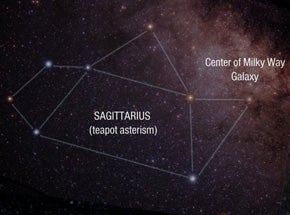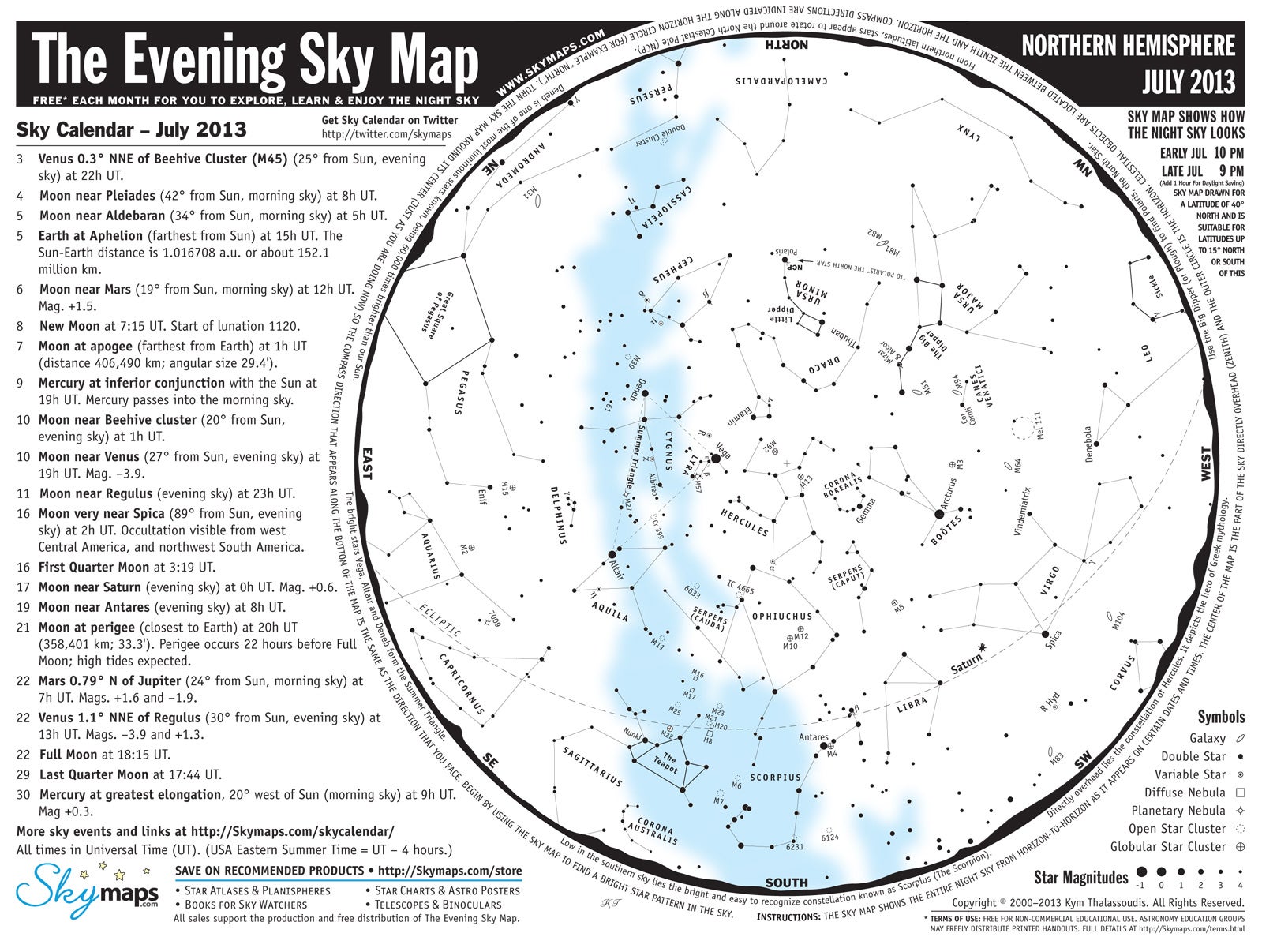Midyear night dream
ListenTomorrow is the exact middle of the year, and Friday marks aphelion – the earth’s greatest distance from the sun for 2013. Venus remains the beacon in the west for the summer. Saturn still dominates as the main planet to observe but remember it is 885 million miles away and so even at its great size, it’s distance makes its apparent size quite small. Jupiter and Mars are in the pre-dawn sky but still too close to the sun to be seen easily. They’ll show better toward mid-month.
July 1, 2013
[Dave Heller] Tomorrow marks the midpoint of 2013. Let’s set our watches with Derrick Pitts, chief astronomer at the Franklin Institute. So Derrick, is this a clock or astronomical estimation?
[Derrick Pitts] It’s a little bit of both. You have to figure out which side of the planet you’re on and then let the astronomical positions of the Earth and the sun do their thing. So here’s where we are: we’re halfway around our orbit around the sun. So depending upon when you actually want to count the beginning of the day, and the beginning of the year, whether you’re on this side of the planet or on another side of the planet, that will determine exactly when the midpoint of the year is for you tomorrow.
Now, “side of the planet” — do you mean top or bottom, or left / right?
I actually mean left or right. You know we actually begin all of our geographical measurements and for that same reason astronomical measurements from Greenwich in England. So if we were to count the beginning of the year as having started in Greenwich then what that means is that at the midpoint of the year would come at noon Greenwich time, which would be 8 a.m. here on the east coast. But if you count the beginning of the year as having started at midnight on January 1 local time, then what that does is that it pushes the midpoint of the year back to noon Eastern Time, in daylight savings time.
There’s another point of note later this week, though this one is measured in distance rather than time.
Yes, you’re right. We actually come to the most distant point in our orbit from the sun on the 5th, this Friday, so we’ll be a pretty good distance away from the sun. It may seem counter intuitive because the temperatures have been so warm of late, but as we’ve come to learn, it’s not the distance from the sun that matters, not the proximity, it’s the tilt of the Earth that makes the difference. So, at this point the top of the Earth, the northern portion where we are, has our greatest amount of tilt toward the sun so we get the greatest amount of solar gain for the course of the year. And the difference between our most distant point on Friday and our closest point to the sun, which always comes at the beginning of January, is about 3.4% difference. So it’s the difference between 91 million miles approximately, and 94 million miles away. So at this point, we’re at the 94 million mile-plus mark, and then in January, we’re at the 91 million mile-plus mark.
Out of curiosity, are the other planets in our solar system in a similar, slight out-of-round rotation?
Yes, they are. Their orbits are slightly elliptical, so that gives them the apogee and perigee that we see. Of course, apogee meaning closer to the Earth or farther from the Earth, but it gives us that close approach and gives all of them the close approach and the more distant point in their orbits.
-

The above amateur photograph of the Sun was taken through a small telescope and a standard digital camera. In contrast, there are times when our Sun appears much more active. (NASA / Ralph Encarnacion)
Well let’s head outside and take stock of those planets that can be seen this week.
In the evening sky, Venus is still the main beacon in the west for the summer. You can see it just after the sun sets without any difficulty at all, nice bright light over on the western horizon. But Saturn still dominates as the main planet to observe. But remember: Saturn is very, very far away us. It’s 885 million miles away from us. Venus is much closer, just a little over average distance from the sun, I should say, 62 million miles. So what that means is that Venus is about 33 million miles from us on that average. So when we see Venus in the evening sky, we’re looking over a very short distance, really. But when we look out at Saturn, we’re looking over an incredible distance. Now when we compare the sizes of the two planets visually, Venus of course looks much larger. Partially because, mostly because, all of because, it’s so much closer to us. Saturn on the other hand is a gas giant planet. And we can fit multiple numbers of planet Earth’s inside the planet Saturn. So it’s distance that makes it appear so much smaller. And these are things to keep in mind when you’re observing the planets in the evening sky.
Were Saturn merely the size of Venus, would it even be visible with the naked eye?
If Saturn were to be the size of Venus at Saturn’s current distance, Saturn would not be visible with the naked eye. You’d need a telescope to see it because it would be comparable in size to the moons of both Jupiter and Saturn. We can’t see those without a telescope. So it would not be visible if you were to shrink Saturn down to the size of Venus.
If we go around to the morning sky, we find that Jupiter and Mars are there in the predawn sky, but only minutes before the sun. So they rise just a little bit before the sun rises, and we’re now talking about 5:20 in the morning, so they’re too close to the sun to be easily seen. However, by mid-month, they’ll move out ahead of the sun so that first Mars and then Jupiter will be easy to see in the predawn sky. By month’s end we’ll be able to see them quite well; but we know they’re there, we just can’t look at them just yet.
This is summertime, I presume the entire panoply of summer constellations is available to be seen.
Yes, there’s a great set of beautiful constellations to see. The typical ones we look for in the summer sky are the ones that are high overhead: Lyra, Cygnus, Altair — the three main constellations that make up the summer triangle. I’m going to urge listeners to look for two others that are somewhat more difficult to see. They’re on the southern horizon: Sagittarius and Scorpius. I mention them because they have bright stars, they have distinctive shapes, but because they’re on the southern horizon we often ignore them, mostly because of any sky glow that we may see. But these are two constellations of the summer sky that come and go fairly quickly because they’re so low on the horizon, the arc that they make across the southern sky is quite small. So they don’t stay around as long as the overhead constellations do. Scorpius looks like a big “S” in the sky down in the south; it has a bright red star called Antares that marks the heart of the scorpion, for which this constellation is named. And then just to the left or to the east of that, is the teapot shape of the constellation Sagittarius. Sagittarius actually means “the archer” but the archer is much more difficult to see than the teapot shape is. And when we say “teapot” we mean teapot! A body, a spout, a handle, a top — all those things there from the childhood song are visible in the bright stars of Sagittarius.
“I’m going to urge listeners to look for two other [constellations] that are somewhat more difficult to see. They’re on the southern horizon: Sagittarius and Scorpius … these are two constellations of the summer sky that come and go fairly quickly because they’re so low on the horizon.”
Derrick Pitts
-

Sagittarius “Teapot”
Is it your experience that most people would say that they most easily recognize the Big Dipper, even if they’re confusing it with the Little Dipper? Is that the most readily identified constellation?
Even if they confuse it with the Pleiades, which also looks like a Dipper, or with Orion, it turns out that the Big Dipper as we know it is one of the best known asterisms of all, anywhere around the world! Even though it has different names, the Big Dipper as we know it is still one of the most recognized star shapes anywhere.
So in order to find these constellations, it may be helpful for you to use a star map. Skymaps.com will provide you with a free printable sky map that you can use to locate constellations in any season sky. Here we are in the summer, you can look for that one, or if you’re on the digital side of things, there are great apps you can use that will help you locate these items as well. Go Sky Watch is a really great one, give that a try. These two things will help you identify the main constellations we spoke about overhead, and the two down on the southern horizon.
WHYY is your source for fact-based, in-depth journalism and information. As a nonprofit organization, we rely on financial support from readers like you. Please give today.





